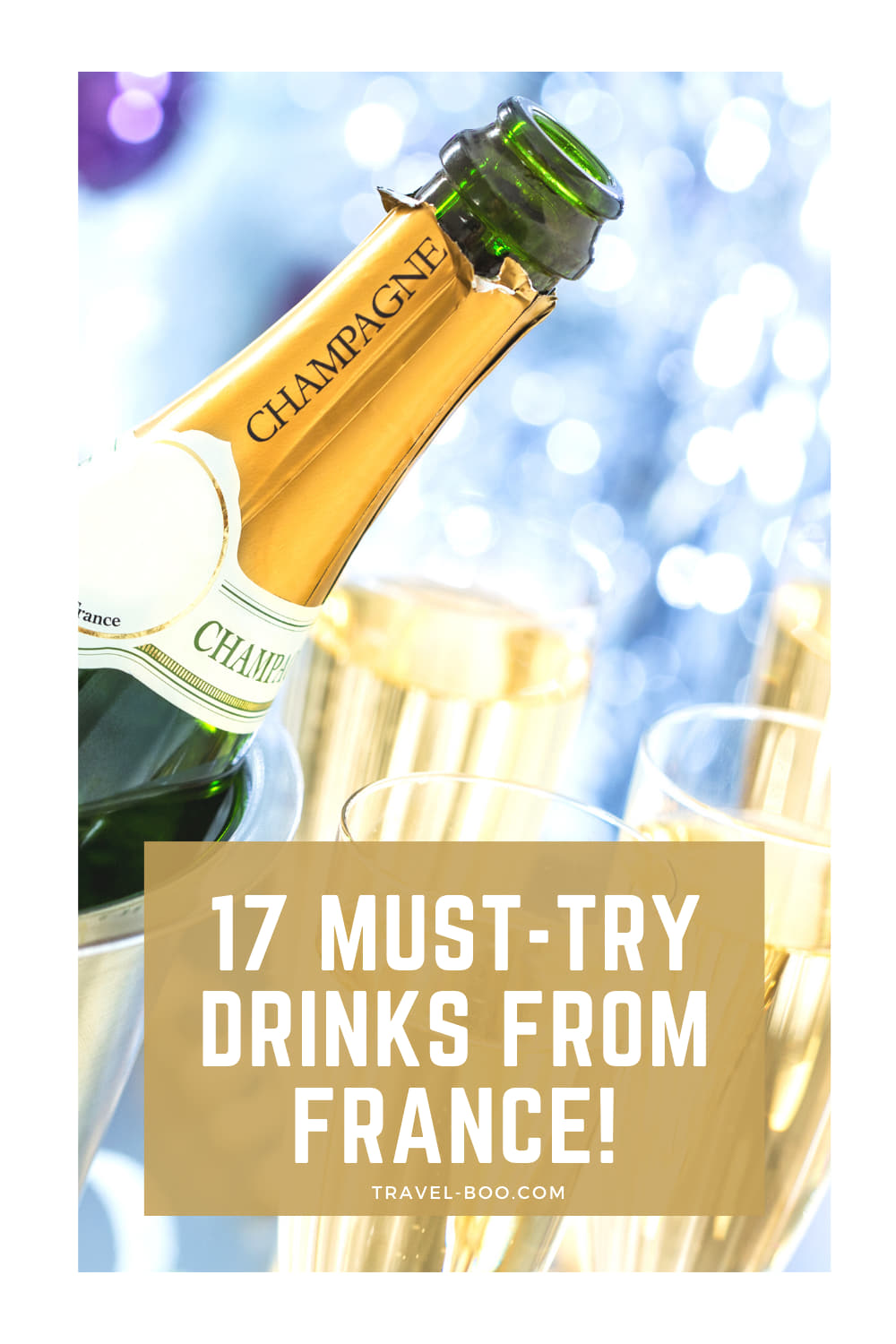Looking for a definitive French Drinks guide? Here is a list of the 17 best drinks from France you simply have to try on your next visit!
Many visit France for its incredible architecture, history, and sights, and iconic French landmarks, whilst others head to the beaches of the French Riviera. Regardless of your reason for visiting France, one thing remains certain. This gorgeous country certainly packs a mighty punch when it comes to French gastronomy.
In saying this, it isn’t just the food that make foodies from the world over flock to France. No, the drinks & beverages found throughout the country are equally as alluring!
In this guide, I’ve collaborated with fellow travel bloggers to bring you a roundup of the best and most popular French drinks to try during your next visit. Whether you’re looking for the perfect French wine, French cocktail, or a non-alcoholic option to enjoy, this post has you covered.
So, grab your favourite French drink and let’s raise a toast. ‘Santé!’
Disclaimer: This post contains links to services or products that I trust and recommend and from which I may earn commissions. Read our privacy policy for more.
| Before you go, be sure to plan & book your trip! | |||
 | Browse & Book Hotels |  | Browse & Book Car Rentals |
 | Browse & Book Flights |  | Browse & Book Buses and Trains |
Pssst…Have you packed all your essentials? Make sure to read our packing list for Europe guide to ensure you’ve ticked all the packing necessities off your list!
Popular French Wines
1. Bourgogne Wine (Burgundy Wines)

By Elisa from France Bucket List
The historical region of Burgundy (Bourgogne in French) produces some of the best French wines and in fact the some of the best in the world, and also the most expensive. The main grape-varieties for Burgundy wines are the pinot-noir for the reds and the chardonnay for the whites.
Burgundy appellation wines are classified on three levels: AOC Grands Crus, AOC Villages, and AOC Régionales. The Grands Crus are the best Burgundy wines and also the most reputed. They represent 1% of the wine production in Burgundy.
You can learn more about the Grands Crus (and do some tastings) by following the Route des Grands Crus. This is France’s most famous wine trail and also the oldest, which goes from Dijon to Beaune, covering a distance of around 80km.
Along the way, you can visit many wine producers but also historic sites related to the Burgundy wine. The Route des Grands Crus in Burgundy is best done by car, but you can also visit some of the sites by train or guided tours.
2. Champagne
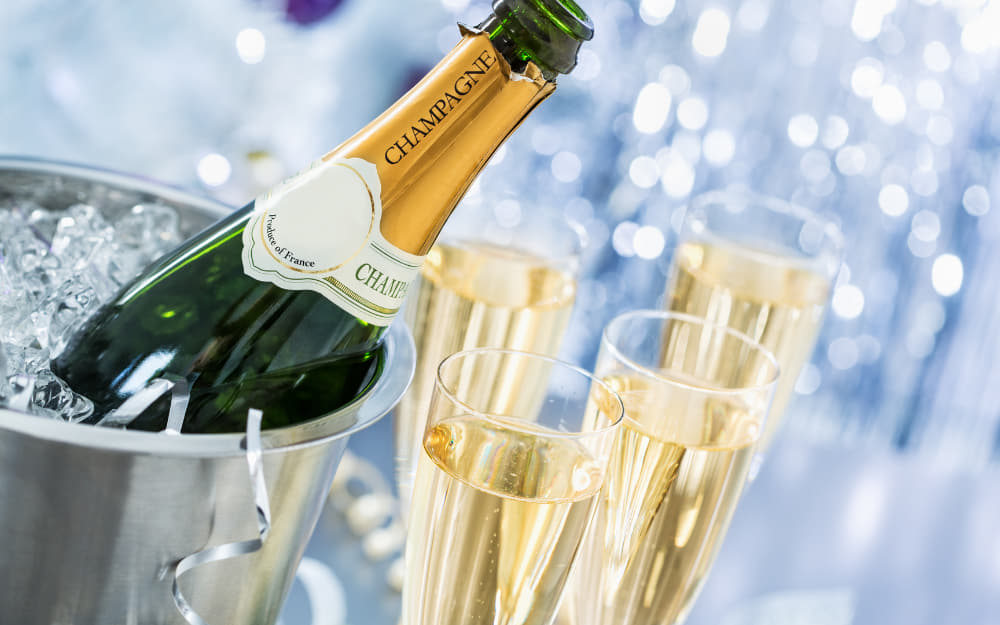
By Elisa from World in Paris
Champagne is undoubtedly one of the most famous French drinks, a festive French sparkling wine that is known worldwide. The champagne is usually drunk for important events or for toasting on good news, that’s why everybody likes champagne!
The champagne is unique and protected. It is only produced in Champagne’s historical region, and any sparkling wine produced somewhere else is not allowed to be named champagne. Other necessary characteristics to be called champagne are the variety of grapes used and the production technique.
Typically, people drink champagne in special long glasses named flutes, and some people like shaking the bottle before uncorking it to make it more festive.
The Champagne wine region is located in Eastern France, and the capital is Reims. It is not far from Paris, that’s why Champagne day trips from Paris are so popular and easy to organize.
The heart of the champagne production is the town of Epernay. Here, you have the main champagne producers like Moët-Chandon, Veuve Clicquot or Nicolas Feuillatte. All these Maisons propose guided tours to learn more about the champagne, and they usually come with tastings at the end of the tour.
3. Merlot Wine

By Victoria from Guide Your Travel
Merlot is, of course, the name of a popular French red wine but it is also the name of the grape from which the wine is made. It’s one of the most popular wine types in the world although the best wines are usually made close to Bordeaux in France.
Some of the best and most expensive wines in the world are Merlot in wine areas such as Saint-Emilion in southern France. Wine experts say that Merlot has subtle notes of plum and cherries and its low acidity makes this wine gentle and easy to drink. Merlot is known to be versatile and can be paired with a wide variety of food items and dishes.
It is most commonly served with red meats such as steak, or lamb. It also works well with a variety of cheeses, especially ones with strong notes. There are actually many different types of Merlot such as Malbec, Cabernet Franc, Cabernet Sauvignon, Carmenère und der Petit Verdot. The most expensive Merlot wine in the world comes from the Chàteau Pètrus in Bordeaux.
4. Pineau

By Breanne from Family Camping Europe
Pineau Des Charentes is a famous French drink from (unsurprisingly) the Charente region of France. A French fortified wine, Pineau, is produced using grape juices and Cognac (a drink also of the Charente region of France). One can find Pineau Des Charentes in shops throughout France, in the Poitou-Charente region of France, particularly, it can be found in abundance. However, the best way to acquire Pineau is by going directly to a producer.
There is quite a story about how Pineau Des Charentes came to be. Legend has it that in the late 1500s, a wine producer added grape juice to a barrel assumed to be empty, but as it turned out, contained Cognac. Years later, the barrel was retrieved, and Pineau-des-Charentes was created.
It can be drunk alone or as part of a cocktail. It is usually served as a sweet aperitif with dinner, although it can also be paired with many meals and desserts. It is best served in a sherry glass to enhance the aromas. It’s a delicious drink, and definitely a must-try if you are in France.
5. Provence Rosé – Good French Wine

By Nadine from Le Long Weekend
While there are many wine varieties grown in the South of France, there’s just one wine that comes to most people’s minds when thinking of Provence. Rosé accounts for 82% of the wine produced in the region, and it’s the tipple of choice for locals and visitors alike.
Provence rosé wines are typically dry, crisp and pale in colour, and pair beautifully with the Mediterranean style cuisine enjoyed in the region. Interestingly, it was the Greeks who brought grapes to the South of France, and the Phocaeans who first pressed it into the pale pink wine now known as rosé.
Unfortunately, some of the earliest vineyards didn’t survive past the 19th century when the Phylloxera epidemic wiped them out. But the fresh start gave many chateau owners an opportunity to grow different types of grapes, such as the Marsanne grape in Cassis, or the Mourvèdre red grape in Bandol.
Nowadays, many vineyards around the region are destinations in themselves, with art installations, restaurants and regular music and theatre events being held on site throughout the summer months. If you’re looking to enjoy Provence rosé at home, pair it with summer salads, fresh fish dishes, or your favourite Thai or Japanese dish.
French Spirits
6. Rhum Agricole – Carribean French Spirit
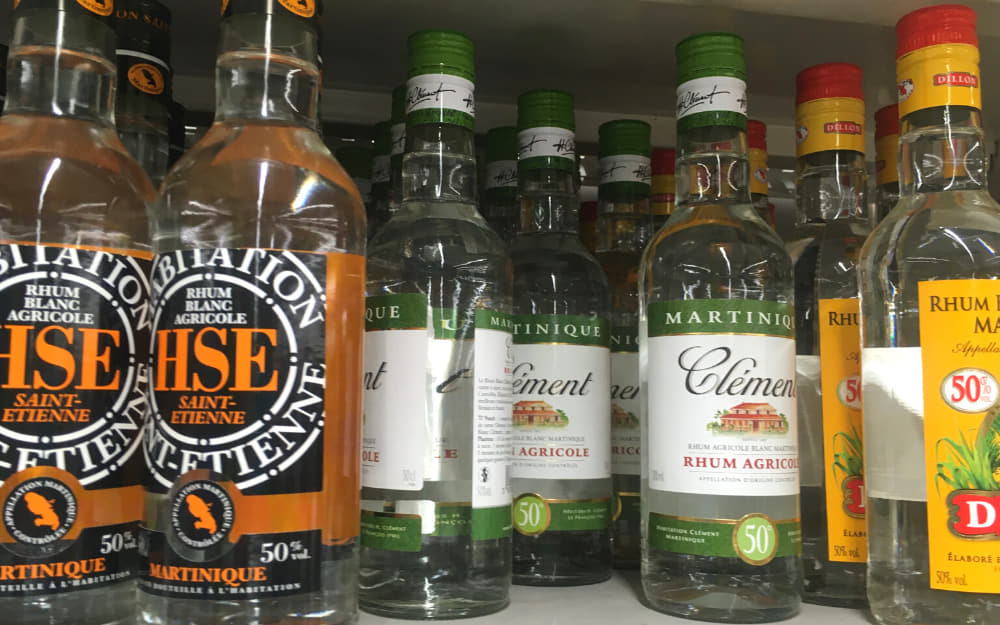
By Sarah from A Social Nomad
The Caribbean is known for its rum, but Rhum Agricole is a specific type of rum that comes only from the Caribbean French Antilles. Most rum is distilled from molasses or beet sugar, which is fermented sugar cane juice, but Rhum Agricole is distilled only from pressed sugar cane juice. These rums from Martinique are labelled AOC (Appellation d’Origine-Controlee).
This method of producing rum came from the collapse of the world sugar markets and the economic necessity and was driven by Homère Clément at the Habitacion Clement distillery on Martinique. The process of producing Rhum Agricole was perfected through his love of French Cognac. Habitacion Clement is, today, a glorious place to visit in Martinique – and of course, a great place to taste Rhum Agricole. It is the most famous of Martinique’s distilleries is Habitacion Clement, which has a quite fabulous paid tour that includes tastings at the end. It is one of 12 brands of Rhum Agricole distilled on Martinique.
You’re most likely to taste Rhum Agricole in an aperitif served in Martinique. Ti Punch is made with Rhum Agricole, lime and cane syrup. No ice, if you’re going traditional. And the traditional way to prepare it is, in French, “chacun prepare sa proper mort”. The English translation is that “each prepares their own death”. It simply means that the barman gives you all the ingredients and you prepare it to your own taste.
French Liqueurs
7. Chambord
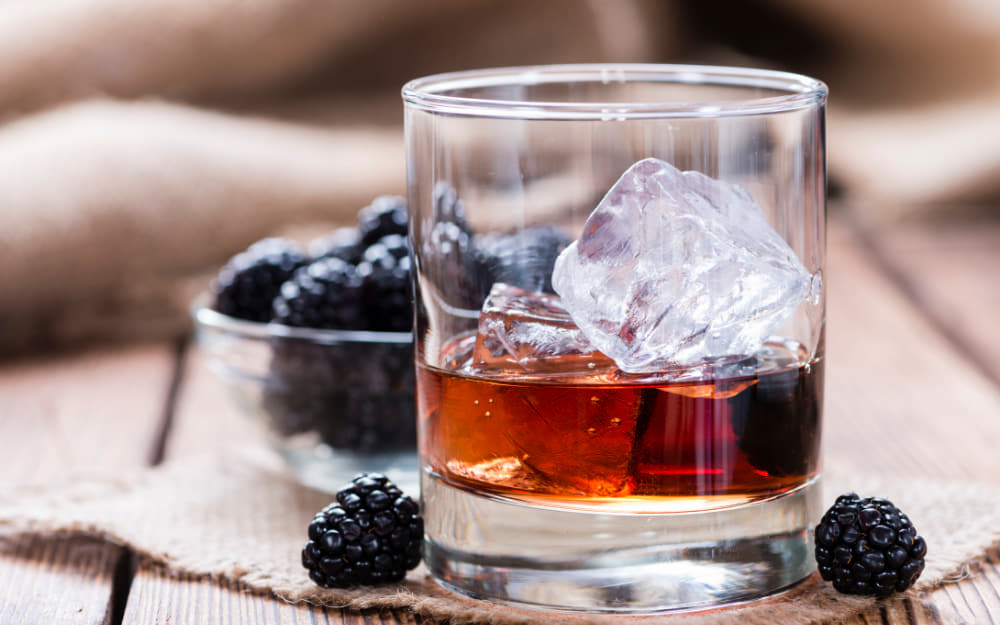
By Josh & Sarah from Veggie Vagabonds
For a fruity and versatile tipple, Chambord is the perfect option. It’s a low-alcohol liqueur, made from red and black raspberries and topped up with vanilla, orange and honey. It’s a zesty and unique taste which is made even more distinctive by its dome-shaped and golden-ornated bottle.
Unlike other famous French spirits and alcohols, Chambord is new to the family. It was first established in 1982 but was inspired by a raspberry liqueur that was drunk by French royals in the 16th century.
If you’re a cocktail fan, and you like berry-flavoured drinks, it’s likely you’ll have had Chambord already. It’s very common in daiquiri, manhattan and margarita alternatives, as a spritzer topper and goes beautifully with champagne too, known as a kir impérial.
Though it is produced in the Loire Valley, you’ll find Chambord all around the world. You can try it in its home setting on your visit to France or test it out in cocktails closer to home.
8. Chartreuse

By Cecily from Groovy Mashed Potatoes
Chartreuse easily gives itself away by its unique green colour. In fact, it’s the only liqueur in the world that is naturally green and is another of the top French drinks to give a try.
Don’t be mistaken by its fruity shade though, this herbal French liquor packs a mighty punch with its 55% (110 proof US) alcohol content. Chartreuse is one of the oldest French liqueurs and was originally used as a health elixir by monks from the Chartreuse Monastery in the early 17th century.
Today, its secret recipe is only known by two monks and has a mixture of 130 plants and flowers. The ingredients are macerated, distilled and aged in oak casks.
A sweeter, and softer chartreuse called Yellow Chartreuse was made in 1840 and adapted from the original Green Chartreuse recipe. It has a 40% alcohol content and a milder profile.
Serve Chartreuse as a digestif after dinner or slowly sip it in a brandy glass on the rocks. It should be served very cold.
9. Cointreau – Traditional French Drinks
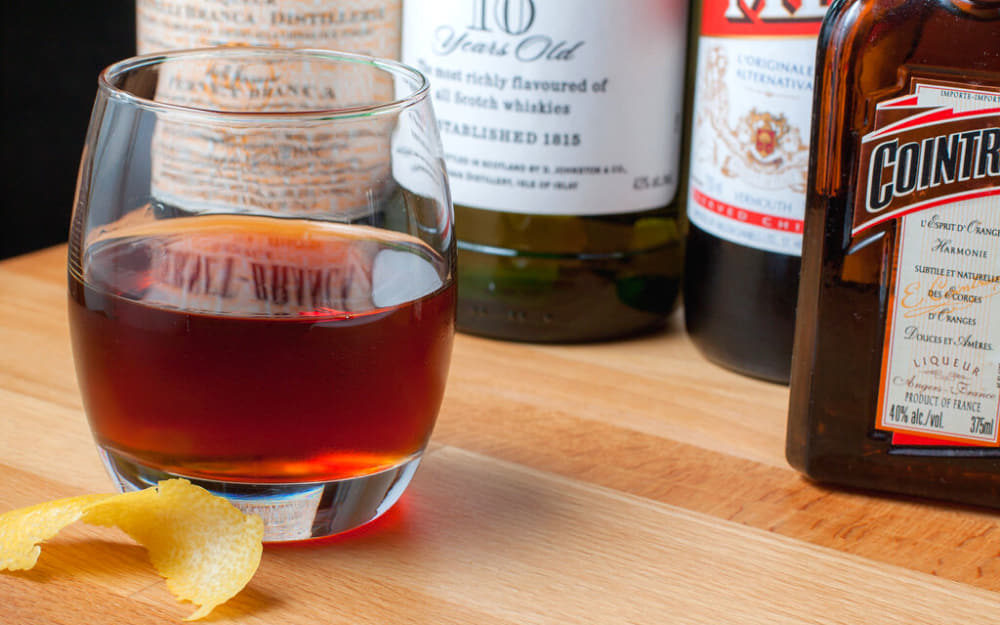
By Alice from Adventures of Alice
One of the most traditional and delicious French-produced drinks has got to be Cointreau. The drink is an orange flavoured, although surprisingly colourless, triple sec liqueur which means that it has been ‘triple distilled’. It can be drunk straight and is most often used as an apéritif (drink served before dinner) or digestif (drink served after dinner).
Cointreau was first invented in 1875 in Saint-Barthélemy-d’Anjou. The pretty countryside area of western France, is a bit of a European hidden gem, near to the city of Nantes. The area is now famous for this French liqueur. Nowadays Cointreau is a well-known French drink that is sold all over the world.
It is also used in many popular cocktails including the Sidecar, the classic Mexican Margharita, the Cosmopolitan or the Mimosa. Originally named Curaçao Blanco Triple Sec, it is stronger than most triple sec liqueurs at 40%. The beautiful orange perfume flavour that Cointreau has is because of the pressed orange skins that it’s made from.
10. Crème de Cassis

By Rosie from Flying Fluskey
Another of the famous French alcoholic drinks is none other than Créme de Cassis, a deep purple, sweet, and sticky blackcurrant liqueur. It is Burgundy’s second most famous alcoholic export but is also made in other locations in France, such as Dijon.
France produces around 16 million litres a year, much of which is consumed domestically but plenty is shipped abroad. To create créme de cassis, blackcurrants are crushed and drenched in alcohol before being doused in plenty of sugar. The result still has all the tannins and tart tang of the blackcurrants along with its sweet start.
It can be drunk at room temperature as an after-dinner liqueur, added to coffee for a fruity kick or turned into a classic cocktail. For a cheap and cheerful mix, add it to a dry white wine. This is known as a “Kir” and will set you back around €3 in a Paris bistro. It was named after the mayor of Dijon, Fix Kir who came up with the idea and called it blanc-cassis. Alternatively, and sensibly, go all out and have a “Kir Royale”. This is 1/5 of créme de cassis topped carefully with 4/5 of champagne.
11. Ratafia

By Pauline from BeeLoved City
If you want to try an authentic French drink, Ratafia will be perfect for you.
It’s a fortified wine made with marc and unfermented grape juice. It is produced in vineyards by using the leftovers and surplus of production.
Ratafia is quite an old drink. It originated in Champagne over 800 years ago! You can also find it in other wine regions such as Burgundy or in the Perigord where it is flavoured with plums.
It’s nicknamed « l’apéritif du vigneron » which means the winemaker’s drink. Back in the days, you would only find it on the farmers’ table!
Ratafia is a convivial drink that you share with friends while chatting away. It usually is consumed as a l’apéritif (before lunch or diner). It is quite sweet but not too strong (15%), hence often classified as a liqueur instead of a wine.
In the South West, it’s also used as an accompaniment with rockmelon or foie gras.
You can find it in some supermarkets in France, however, it’s still considered as a local and traditional product so the best place to buy a bottle is a local shop or from the producer directly.
French Cocktails
12. Monaco

By Eileen from FamiliesGo
I discovered the Monaco French cocktail on a summer visit to Nice. You can order it anywhere in France, especially in summer but its colour and flavours are particularly suited to Nice’s warm, sunny Mediterranean climate.
It’s a roughly 60/40 mix of beer and lemonade with a spoonful of grenadine syrup to make it a lovely sunset pink. It sounds like an odd combination—I questioned the idea of sweet beer the first time my now-husband ordered it for me. But it’s just a variation on the English shandy and German Radler, and it’s surprisingly appealing.
A Monaco is one of those refreshing, lightly alcoholic cocktails that’s just the thing on a summer afternoon. Try it after a day at the beach, a long bike ride or a day of sightseeing.
Here’s how to make a batch to add a dash of international flavour to your next summer soiree: Try to find the sparkling not-to-sweet lemonade that’s everywhere in Europe (gourmet grocers often have it and Fanta will do in a pinch). And use the good-quality grenadine you find with the cocktail mixers (or buy a bottle of grenadine syrup while you’re in France). In most French bars they’ll use Stella Artois but if you’re not a fan you can try any Pilsner, Helles or Bier de Garde. Of course, you can adjust the beer-to-lemonade ratio and the amount of grenadine to suit your own tastes. Santé!
French Ciders
13. French Ciders

By Nicholas from Rambling Feet
The cultivation of apples was widespread throughout the Roman empire and this included the region that France lies in today. French Cider—or cidre as it is known in France—remains a speciality of the Northern regions, such as Brittany and Normandy and is another of the most popular French drinks you should try out in France.
It’s brewed from the juice of local apples to varying strengths and sweetness levels. Most French ciders tend to be fizzy and light at 5% ABV or less, but stronger ones exist, and they may even be distilled for calvados. Some are even packaged like champagne, complete with caged corks and punts.
The labels indicate whether they are doux (sweet), demi-sec (medium-dry) or brut (dry). The best accompaniment to this drink is a Breton galette, a savoury filled buckwheat crepe (thin pancake) that originated in Brittany. It is traditional for creperies there to serve cider in ceramic cups called boules. A failsafe choice is a galette complete—the fruitiness pairs extremely well with the Emmental cheese, ham and an egg.
Non-Alcoholic French Drinks
14. Diabolo Menthe
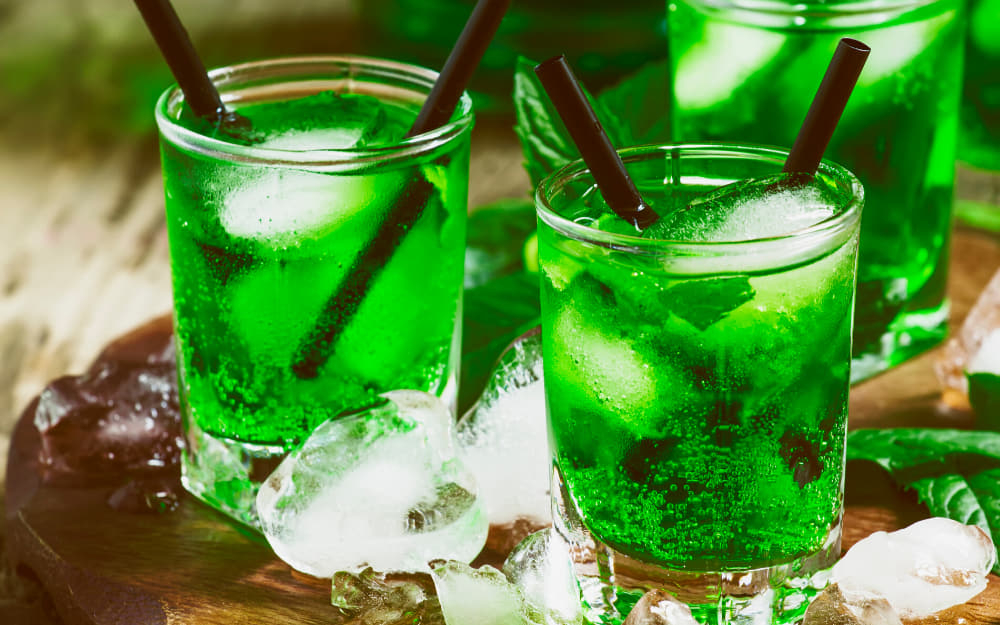
By Mayi from Secret Moona
The first drink that comes to my mind when thinking of popular french drinks is “Diabolo”, a delicious, refreshing and inexpensive summer cocktail. The Diabolo is a glass of homemade lemonade or French lemonade mixed with a little bit of Teisseire syrup.
Cafes and bistros all around France serve this summer drink which comes in different flavours like mint (menthe), grenadine, strawberry, raspberry, passion fruit and many more. Every child growing up in France has had this refreshing drink. Some of them will serve the Diabolo with either Sprite or 7Up. Another variation you can find in cafes is “menthe a l’eau”, a green mint syrup with iced water.
The popular minty green Diabolo Menthe is such a classic that all the grown-up children still favour the drink. Whenever I’m in Paris during the summer, I love sitting on the terrace of a cafe, sipping an iced cold Diabolo Menthe while people-watching.
15. Gini Lemon

By Emma from Emma’s Roadmap
Gini Lemon is an originally French soda drink that was invented in 1971 by the French company Perrier which you definitely know from the sparkling water, and in 1989, the drink got purchased by Cadbury Schweppes. This sparkling soda tastes like bitter lemon and is the ultimate non-alcoholic refreshment when visiting France!
Surprisingly, in France, this drink is also known as “La plus chaude des boissons froides” or the hottest of all cold drinks. Why, you ask? In the 20th century, this drink became popular through very remarkable campaigns referring to sexually tinted activities. This is how they became the “hottest” drink of all cold drinks!
Gini is not only popular in France, but also in its neighbouring countries. In Belgium, for example, it is now also one of the most popular lemon drinks. Besides being a very tasty drink on its own, Gini is also perfectly suited to make cocktails, for example, as input for a bittersweet mojito!
16. Orangina – French Drinks
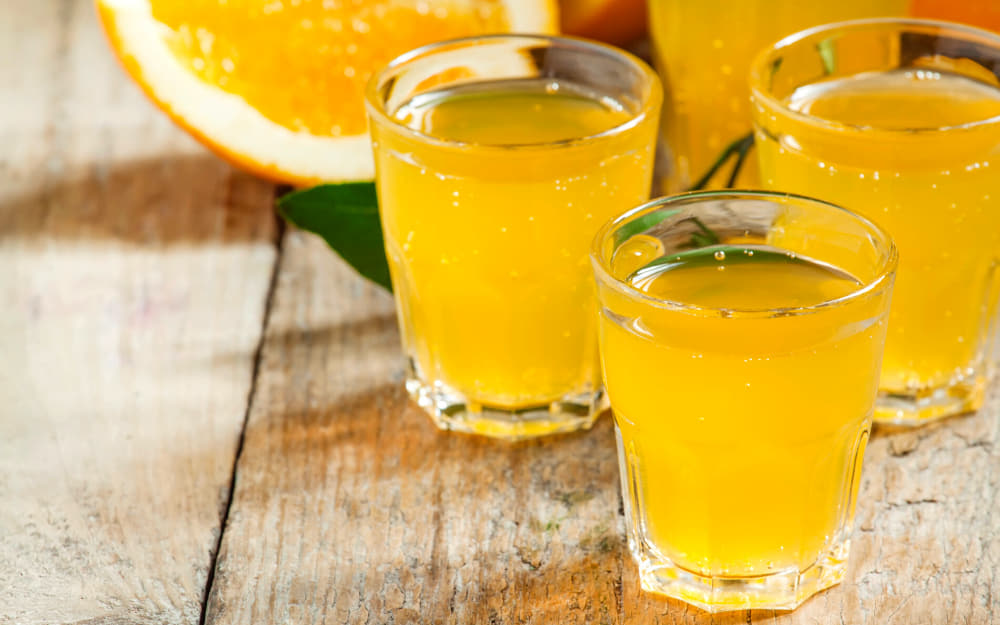
By Ucman from BrownBoyTravels
Oringina is as french as it gets when it comes to carbonated drinks. It started off in 1930s and gained real popularity later.
Funny enough it was developed by a Spanish scientist in Valencia (no surprise, Valencia’s oranges are the best in Europe) but the idea was bought by a fence businessman during a trade fair. Monsieur Beton then took the brand forward and with time it became a very french drink. It has a very specific bottle shaped like an orange with the same texture at the bottom with an elongated neck.
Orangina is slightly carbonated with some orange pulp, mostly orange with a hint of lemon and grapefruit. This gives it that kick with the fizz that makes it the original Orangina.
The drink is common for kids as well as adults and it is fast becoming a staple for cocktails with new-age bartenders experimenting. It is also used as a mixer for spirits with the younger generation.
Orangina is the light, refreshing french drink for summers, one you cannot avoid during a trip to France.
17. Perrier

By Dymphe from Dymabroad
One of the most popular non-alcoholic drinks in France is Perrier. Perrier is simply delicious sparkling water. It comes from a source in the French village of Vergèze. A trip to France should always include Perrier, even if you are only in Paris for a layover.
What’s great is that the carbonation of the water is natural. The water in the Perrier spring is carbonated, and the water and gas are collected separately. During bottling the gas is added back to the water in the same concentration as how it occurs in the water of the spring.
The spring has a long history. The Romans used it as a spa and still in 1898 it was in use as a spa. Only later did people start selling bottled water. Perrier is sold in green bottles that have a unique shape. All bottles are in the shape of a droplet, undoubtedly recognizable.
Perrier is always great and it fits every meal. If you want to taste a water that tastes wonderful, then you should definitely try Perrier!
